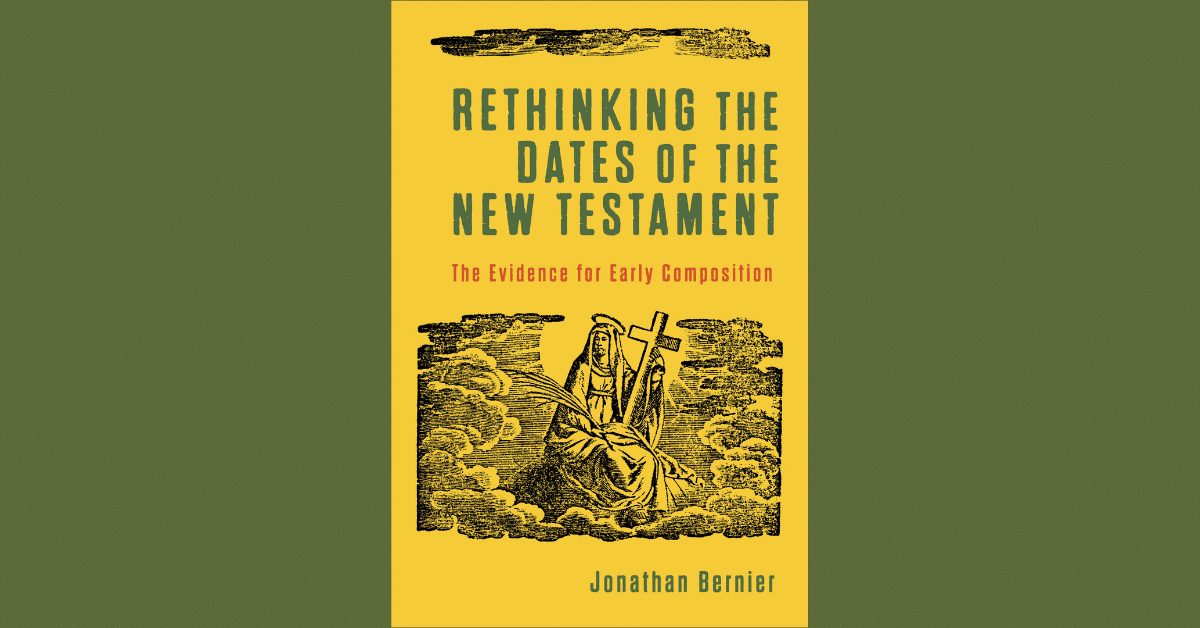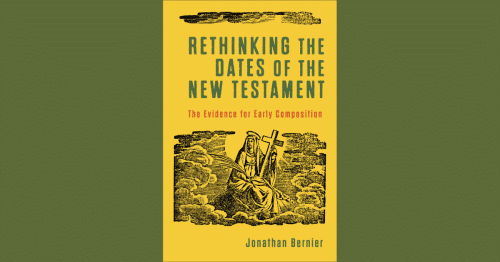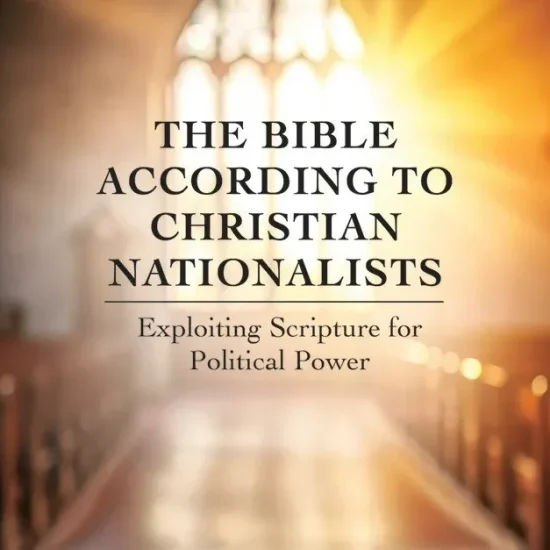

RETHINKING THE DATES OF THE NEW TESTAMENT: Evidence for Early Composition. By Jonathan Bernier. Grand Rapids, MI: Baker Academic, 2022. Xvii + 318 pages.
Does the date of composition matter when it comes to either interpreting the New Testament or receiving it as an authoritative word for the church? Is early better than later? What about those extra-canonical texts like the Didache or the Shepherd of Hermas (you thought I was going to say the Gospel of Thomas!)? If they date to the same period as the canonical texts, does that give them more authority for the church today than if we date them later? We pretty much know that Paul’s undisputed letters were written in the 50s CE, but what about the Gospels and the other letters and texts? Do we really know when they were written? Could we misread clues that suggest later dates for texts than perhaps they might have been written? Oh, and is this a conservative-liberal argument? In the end, does any of this matter?

Robert D. Cornwall
I lay before you my review of Jonathan Bernier’s argument on behalf of an early composition of the New Testament. Now, I’m not a biblical scholar. Yes, I’ve taken my share of graduate-level New Testament classes, As an academic scholar, my area of expertise is 18th-century British Church History. Nevertheless, I am deeply interested in how people interpret the Bible, and whether they do so responsibly. While I was educated in more evangelical contexts, I inhabit a more liberal space. That being said, when it comes to dating texts, I’ve always wondered why many liberals pushed for late dates of composition. Of course, one scholar who embraced early composition was the famed liberal Anglican bishop John A.T. Robinson, author of the rather controversial (for the early 1960s) book Honest to God. So, early composition isn’t necessarily a conservative position. While I perceived Bernier to be on a more conservative side of things, he teaches at a Jesuit institution and is a follower of an important Jesuit theologian, Bernard Lonergan. The fact that he draws on Robinson’s position, though he improves upon it, suggests that he is interested in separating this conversation from the typical conservative-liberal debate.
For my purposes, we begin with the tendency that has existed since the turn of the 20th century, if not earlier, to assume that most New Testament books, including the Gospels, date to a period after 70 CE, if not later. There is justification for doing so, but is it possible that the majority of the New Testament texts date to a period before 70 CE? That was the position taken by John Robinson. So, is there “evidence for early composition?” As the subtitle of Jonathan Bernier’s intriguing book suggests, he believes there is significant evidence for taking that position. That has interesting implications for how we read texts, especially the Gospels. While I have generally followed the majority position that assumes that the first gospel written, the Gospel of Mark, should be dated to a period sometime after the fall of Jerusalem, based on Jesus’ references to the destruction of that city. If that is true, then the other Gospels have to be dated even later. But what if Mark was much earlier, perhaps as early as 45 CE? Are you intrigued by that possibility? I am. That would mean Mark predates Paul’s letters.
Before I go any further I need to introduce you to the author of the book Rethinking the Dates of the New Testament: The Evidence for Early Composition. Jonathan Bernier is the assistant professor of New Testament and executive director of the Lonergan Research Institute at Regis College, University of Toronto. Regis College is a Jesuit school. He holds a Ph.D. in New Testament from McMaster University and has written a previous volume on the quest for the historical Jesus.
When it comes to dating the New Testament, according to Bernier, there are essentially three positions. There is a lower date of composition, middle (majority), and higher. Not being an expert in these matters I tend to follow the majority position on things like this, and so I tend to follow the middle chronology. That seems safest. Nevertheless, I try to keep an open mind. Of the two other possibilities, I’m more inclined to go with earlier dates than later ones. I’ve always felt that the arguments that suggest, for example, that the Gospel of Matthew was written in the second century are based more on ideology than evidence. Now, concerning Paul’s undisputed letters, there is no conflict. Everyone seems to agree that most of Paul’s undisputed letters were written in the 50s CE, and early 60s at the latest. As for the rest, well, we’re left looking for clues that suggest possible dates.
What Bernier wants to do with this book, which is rather technical, is demonstrate that it’s possible to fit most of the New Testament into the period before 70 CE. In fact, in his view, that makes the most sense of the evidence, even if much of the evidence is circumstantial. In doing this, Bernier largely follows, though not always, the trail blazed earlier in the mid-twentieth century by John A. T. Robinson. He points out that he and Robinson are essentially the only scholars who have attempted to provide a study like this. He notes that no comparable study has yet to be undertaken on behalf of the Middle and Higher positions, at least not since the turn of the 20th century. Having offered this defense of a lower date, he challenges advocates of the other two positions to do the same kind of study. Then we can compare the arguments based on the evidence we have before us.
While I count myself among those who embrace the middle position since it’s the majority position among New Testament scholars and since I’m not a New Testament scholar I tend to trust their judgment, I find the idea of early dating intriguing. That is especially true of the Gospels. If, as Bernier suggests, Mark was written as early as 45 CE, with Matthew being written around 50 CE, that would mean two of the four Gospels were written before Paul’s letters. That would also mean that we would have evidence of Jesus’ life and ministry that dates to a period a little more than a decade after his death (and resurrection)? To get there, of course, we have to deal with how we read passages dealing with the destruction of Jerusalem in 70 CE.
While Bernier starts with Robinson, he wants to go beyond Robinson’s Redating the New Testament (1976). One of his major concerns with Robinson’s approach is “his less-than-adequate attention to the method and organization of his study.” (pp. 8-9). Thus, Bernier wants to address concerns about how 70 CE is interpreted, as well as how one interprets the reigns of Roman emperors Domitian and Nero. Interestingly, Bernier, like Robinson, is less than enthralled with the idea of large-scale persecution under Domitian. As for Neronian persecution, which Robinson drew upon, Bernier notes that it was too localized in Rome to influence events elsewhere. While he addresses these concerns, it is Robinson’s method and organization, though not the conclusions, that he finds most problematic and wishes to improve upon.
Central to Bernier’s argument are three methodological concerns: synchronization, contextualization, and authorial biography. The first piece, synchronization, focuses on the attempt to establish “the text’s temporal relationship to other events or situations, including the composition of other texts.” Thus, here is where the question of the events of 70 CE comes into play. The questions he asks under this rubric have to do with whether there is “material in the book that is most fully intelligible only if written before a given event or situation?” The other question has to do with whether there is material that is most fully intelligible if written after the event. Questions here include external attestation and reception. The second criteria concerns “contextualization,” which has to do with establishing “the text’s probable relationship to the general course of early Christian development in areas such as ecclesiology, Christology, gentile inclusion, and so on.” (p. 26). The challenge here is not falling into the trap of circular reasoning, such that a development scheme is used to establish a chronological one, which in turn is used to defend the original scheme. Finally, he looks at the authorial biography. He admits the challenge of precision regarding the identity of the authors, with the exception perhaps of Paul. Of course, biography has to do with authenticity, but he has chosen not to dive too deeply into such arguments. However, he does address in four cases questions of pseudonymity. These would be the three pastoral epistles and 2 Peter. He gives two date ranges depending on whether these are to be considered authentic or pseudonymous. Yes, he affirms Pauline authorship of Ephesians and Colossians and Petrine authorship of 1 Peter.
With these criteria in mind, Bernier takes us through the New Testament, beginning with the Synoptic Gospels and Acts. As noted, he suggests that there is evidence for dating Mark to 45 CE, with Matthew following in 50, and Luke in 60, with Acts sometime after 62. With Acts, he notes that it ends with Paul in Rome, having been there for about two years. With that, the book ends. Does that suggest that it predates Paul’s death? If not, then what is a better solution? From these texts, we move in Part 2 to the Johannine Tradition, with a chapter on the Gospel and one on the Epistles and Revelation. He deals with the Pauline texts in Part 3, setting a chronology that fits what the majority of scholars agree upon. Finally, we move on in Part 4 to Hebrews along with the letters of James, Peter, and Jude. For the latter he sometimes offers a fairly broad range of dates, knowing that dating Hebrews with precision is difficult.
Part 5 of the book is interesting as Bernier takes a look at four extracanonical writings—1 Clement and the Didache (chapter 9), along with the Epistle of Barnabas and the Shepherd of Hermas (chapter 10). He chose these four in large part because these were the texts chosen by Robinson in “Redating the New Testament.” He suggests that other texts need similar attention, but this starts the process. While I’ve always assumed 1 Clement was written around 95 CE, he suggests that the evidence puts it between 65-70. It can’t be earlier than that as he reports the deaths of both Peter and Paul. The letter also mentions a Fortunatus. If this is the same Fortunatus as the one mentioned in 1 Corinthians 16:17, would he still be active forty-plus years later? All of this is intriguing.
What made John Robinson’s attempt to redate the New Testament so challenging in the 1970s to the reigning views was that he was not a conservative. As the author of Honest to God, he had strong liberal credentials, and yet he argued for a dating scheme that had been the province of conservatives who wanted to cement the authority of the New Testament. That surely wasn’t Robinson’s desire, as liberals like him tended to question the authority of the Bible, and thus a later date fit their needs better. While I sense that Bernier is more conservative than the average liberal, his argument doesn’t appear to be ideological. Like Robinson, he believes an earlier date for the books fits the evidence better and he offers his rationale for that view while inviting representatives of the other two positions to do the same.
While embracing an earlier view doesn’t necessarily make you a conservative, it is true that such a position does better support the authoritative witness of the New Testament (it doesn’t make it inerrant, just closer to the events narrated). When it comes to the Synoptic Gospels and Acts, if they could be placed early in the life of the church, that is important as fifteen years is a lot closer to the events than forty years later or afterward. While I’m not totally convinced by Bernier, I’m intrigued. I do have questions about moving most everything before 70 CE, and yet perhaps that date is too arbitrary when it comes to deciding whether a text is early or late. There’s much to contemplate here, and I’m not an expert in the field, so I’m keeping an open mind, hoping to see what others do with the challenge. As for why I decided to request a review copy, I need to acknowledge the endorsement given to the book by James McGrath. McGrath is a New Testament scholar I highly regard who is no conservative. I suspect that McGrath remains in the middle, but I believe he’s correct when he writes that Bernier’s arguments “will undoubtedly serve as an impetus to refreshing scholarly conversations for decades to come.” It appears to be time to reassess the arguments on the dates of authorship. Maybe we should be so quick to assume that the attributions the early church gave to the authors of these books, especially the Gospels, are incorrect. Perhaps tradition is correct.
While this is intended to be a scholarly book that addresses the academic community, it is relatively accessible. I say relatively because it can feel like we’re getting into the weeds at points. Nevertheless, Bernier writes with clarity, without getting too caught up in academic language. At least, it’s accessible to those who have a degree of background in biblical studies. In other words, clergy should find it understandable. I do think that clergy will benefit from reflecting on the possibilities of redating the New Testament. By that, I mean those of us in the more moderate to liberal mainline community. The key to the value of Bernier’s Rethinking the Dates of the New Testament is the care with which Bernier dives into the evidence as well as the compelling way he presents the information. So, as we await similar presentations by adherents of the other two positions, why not check out Bernier’s proposal. At the very least it will cause you to think about how dates are given to texts, and whether the method is working!
This review originally appeared on BobCornwall.com.
Robert D. Cornwall is an ordained minister in the Christian Church (Disciples of Christ). Now retired from his ministry at Central Woodward Christian Church (Disciples of Christ) of Troy, Michigan, he serves as Minister-at-Large in Troy. He holds a Ph.D. in Historical Theology from Fuller Theological Seminary and is the author of numerous books including his latest books: Called to Bless: Finding Hope by Reclaiming Our Spiritual Roots (Cascade Books, 2021) and Unfettered Spirit: Spiritual Gifts for the New Great Awakening, 2nd Edition, (Energion Publications, 2021). His blog Ponderings on a Faith Journey can be found at www.bobcornwall.com.






